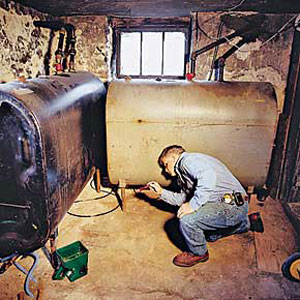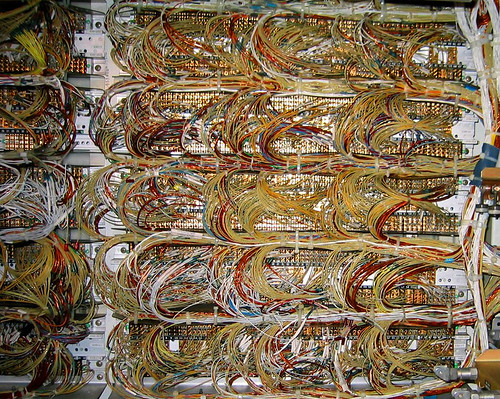 Q. I just had a new two-car garage built and I am remodeling the old one-car garage into a family room. I plan to do some of the wiring myself. What are some of the common wiring mistakes I should avoid?
Q. I just had a new two-car garage built and I am remodeling the old one-car garage into a family room. I plan to do some of the wiring myself. What are some of the common wiring mistakes I should avoid?A. If you have ever seen a new house or remodeling project being wired, it looks pretty simple. The electrician just drills some holes in wall studs and runs some heavy insulated wire through the holes to the various conduit boxes throughout the house.
Don't be fooled. It is much more difficult to do it properly, particularly in a remodeling project where the existing framing is retained. If you make a serious mistake, someone could get electrocuted. Minor mistakes can result in a wire overheating inside a wall. If it gets hot enough, a fire can start inside a wall cavity and spread throughout your house quickly.
The first step is to contact your local building inspectors. Check to see if you need a permit and if an unlicensed electrician is even allowed to do electrical work. If you are allowed to do the work yourself, it would still be wise to have an inspector come to check your work before the walls are closed in order to make sure it meets local codes.
Keep in mind, if you do the electrical work, you are responsible for it as long as it exists. If you sell your house 10 years from now and the new owners are injured due to your unlicensed electrical work, you may be liable.
One of the most common wiring mistakes made is drilling clearance holes too close to the edges of a stud. The edge of the hole in the stud should be no closer than 1¼ inches from the edge of the stud. This is to keep nails, driven into the stud for drywall, from reaching and piercing the insulation on the wiring. If a hole must be closer than 1¼ inches, a protective metal nail plate must cover that area of the stud edge.
Even though it saves time, don't group low-voltage, communication and line voltage (120 volt) lines through the same holes in the studs. Line voltage wires carrying standard alternating current can cause interference with communication wires, such as ones from a computer or telephone. Line voltage wires should always be separated at least six inches from other wiring within a wall.
A more serious problem is if a line voltage line shorts out to a communication or low-voltage wire. This not only can cause a fire to start, but it can destroy any equipment attached to the low-voltage wiring. I have seem the entire low-voltage control system on a furnace destroyed in this way.
Plan all your wiring before purchasing the conduit boxes so you know what size boxes to get. Even the proper-sized wiring can get warm when electric current runs through it. Switches and connections with wire nuts can get even warmer. If you group too many wires, switches, etc., into a small conduit box, it may overheat and become a hazard.
Don't ever hang anything, such as a support for a dropped ceiling or a recessed light fixture, from electrical wiring. This can stretch and weaken the insulation over time which may cause higher resistance, overheating or even a short.






 By Nicole Tsong
By Nicole Tsong



 An original service of knob-and-tube wiring, if properly installed, is and can remain a safe electrical system. Left alone, it would satisfy the electrical demand for which it was designed without any problems.
An original service of knob-and-tube wiring, if properly installed, is and can remain a safe electrical system. Left alone, it would satisfy the electrical demand for which it was designed without any problems. If you’ve got a small service, say up to 100 amps with a fuse box, in a two-story house and you’re thinking of upgrading to circuit breakers, replace it with a 200-amp panel. Don’t argue about it or debate its need, just do it. The last house we owned was a 1924, three-bedroom, one-story bungalow on a street of one-story bungalows. You could easily maintain that it only needed a 125-amp service, but a funny thing happened as Seattle real-estate prices headed toward the stratosphere: These one-story homes started becoming two stories. Owners decided it was more cost-effective to stay put and add on rather than to move. Five of our former neighbors on one block did this very remodeling to their homes. My point is that you cannot predict future needs. Given the relatively small cost difference between a 125-amp service and a 200-amp panel, there’s no point in installing the smaller service in a two-story house. One exception to my 200-amp rule is the presence of gas appliances. Our first house, for example, was adequately serviced by a 125-amp panel because we had a gas furnace, water heater, stove, and clothes dryer. As a result, the biggest single electrical loads in the house were the refrigerator and the washing machine, neither of which were huge draws on the system.
If you’ve got a small service, say up to 100 amps with a fuse box, in a two-story house and you’re thinking of upgrading to circuit breakers, replace it with a 200-amp panel. Don’t argue about it or debate its need, just do it. The last house we owned was a 1924, three-bedroom, one-story bungalow on a street of one-story bungalows. You could easily maintain that it only needed a 125-amp service, but a funny thing happened as Seattle real-estate prices headed toward the stratosphere: These one-story homes started becoming two stories. Owners decided it was more cost-effective to stay put and add on rather than to move. Five of our former neighbors on one block did this very remodeling to their homes. My point is that you cannot predict future needs. Given the relatively small cost difference between a 125-amp service and a 200-amp panel, there’s no point in installing the smaller service in a two-story house. One exception to my 200-amp rule is the presence of gas appliances. Our first house, for example, was adequately serviced by a 125-amp panel because we had a gas furnace, water heater, stove, and clothes dryer. As a result, the biggest single electrical loads in the house were the refrigerator and the washing machine, neither of which were huge draws on the system. Installing a new 200-amp service panel in an older, two-story house, replacing all the existing circuits, and adding new ones to bring the entire system up to code—all this is an expensive proposition. The service alone can cost roughly $1,800 to $2,000. You can easily spend four times that amount wiring the house, depending on its size and the complexity of the new system. I hesitate to quote figures because every house is different, as are local labor rates, but an electrician can give you a ballpark figure, which is subject to change when an actual estimate is drawn up. Some people will replace and upgrade just to be on the safe side, while others should replace and upgrade. The following are signs that you should consider changing your electrical system:
Installing a new 200-amp service panel in an older, two-story house, replacing all the existing circuits, and adding new ones to bring the entire system up to code—all this is an expensive proposition. The service alone can cost roughly $1,800 to $2,000. You can easily spend four times that amount wiring the house, depending on its size and the complexity of the new system. I hesitate to quote figures because every house is different, as are local labor rates, but an electrician can give you a ballpark figure, which is subject to change when an actual estimate is drawn up. Some people will replace and upgrade just to be on the safe side, while others should replace and upgrade. The following are signs that you should consider changing your electrical system:

